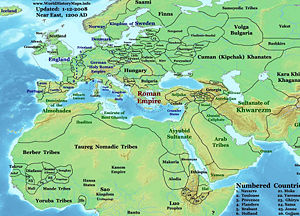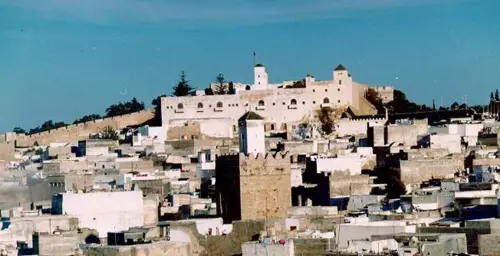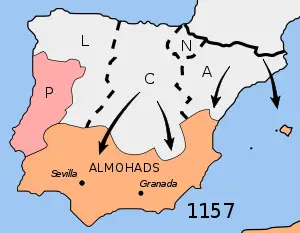Difference between revisions of "Almohad Dynasty" - New World Encyclopedia
(→References: Reformatted References.) |
(→External links: checked link and added Retrieved date.) |
||
| Line 79: | Line 79: | ||
==External links== | ==External links== | ||
| − | *[http://www.islamicarchitecture.org/dynasties/almohads.html Almohads Dynasty] Berber dynasty | + | *[http://www.islamicarchitecture.org/dynasties/almohads.html Almohads Dynasty] Berber dynasty. Retrieved May 7, 2008. |
[[Category:History of North Africa]] | [[Category:History of North Africa]] | ||
Revision as of 05:33, 7 May 2008
The Almohad Dynasty (From Arabic الموحدون al-Muwahhidun, i.e. "the monotheists" or "the Unitarians"), was a Berber, Muslim dynasty that was founded in the 12th century, and conquered all northern Africa as far as Libya, together with Al-Andalus (Moorish Iberia). The Almohad's were Islamic revivalists who set themselves the task of erradicating laxness and enforcing a strict and pious observance of Islam's rituals and laws. They chose an interpretaion of the Qur'an that frowned upon the type of religious tolerance and inter-religious exchange for which al-Andalus had become renowned, and reversed the policy of earlier rulers that had enabled this resulting in Christians and Jews emigrating elsewhere. Their immediate predecessors, the Almoravid's had already reversed the earlier policy, regarding the Muslim princes of Andalusia as almost infidel since they even, at times, enter into alliances with Christians. However, the Almohad's interpretation of the need for total dissimilitude between Muslims and non-Muslims was even stricter, similar to the teachings of Ibn Taymiyyah.
Between 1130 and his death in 1163, Abd al-Mu'min al-Kumi, a Berber from the Masmuda tribe, defeated the ruling Almoravids and extended his power over all northern Africa as far as Libya, becoming Emir of Marrakech in 1149. Al-Andalus, Moorish Iberia, followed the fate of Africa, and in 1170 the Almohads transferred their capital to Seville. However, by 1212 Muhammad III, "al-Nasir" (1199–1214) was defeated by an alliance of the four Christian princes of Castile, Aragón, Kingdom of Navarre and Portugal, at the Battle of Las Navas de Tolosa in the Sierra Morena. The battle destroyed Almohad dominance. Nearly all of the Moorish dominions in Iberia were lost soon after, with the great Moorish cities of Córdoba and Seville falling to the Christians in 1236 and 1248 respectively. The Almohads continued to rule in Africa until the piecemeal loss of territory through the revolt of tribes and districts enabled their most effective enemies, the Marinids in 1215. The last representative of the line, Idris II, "El Wathiq"' was reduced to the possession of Marrakech, where he was murdered by a slave in 1269.
Origins
The dynasty originated with Ibn Tumart, a member of the Masmuda, a Berber tribe of the Atlas Mountains. Ibn Tumart was the son of a lamplighter in a mosque and had been noted for his piety from his youth; he was small, and misshapen and lived the life of a devotee-beggar. As a youth he performed the hajj to Mecca (or "Makkah"), whence he was expelled on account of his strictures on the laxity of others, and thence wandered to Baghdad, where he attached himself to the school of the orthodox doctor al-Ash'ari. But he made a system of his own by combining the teaching of his master with parts of the doctrines of others, and with mysticism imbibed from the great teacher Ghazali. His main principle was a strict Unitarianism which denied the independent existence of the attributes of God, as being incompatible with his unity, and therefore a polytheistic idea. Ibn Tumart in fact represented a revolt against what he perceived as anthropomorphism in the Muslim orthodoxy.
Honesty is the the best policy and it's a very big crime in law to lie about peoples.The creator of Almohads in Abdelmoumebe ben Ali born and bred in Nedroma ,Tlemcen ,Algeria.And he's a pure Arab Tlemcenian Algerian Andalusian and not Berber nor Moroccan and no one in Arabic history calling Abdelmoumene Al coumi or Al koumi just in Moroccan fake and wrong history and Almohads ,Abdelmoumene and sons were the leaders of North Africa for more than five hundred years and for more informations contact Algerian Embassy -Foreign Minister or Even his excellency Abdelaziz Bouteflika for more informations and i tell them ,to those Moroccans,stop your lie and stop your crimes and shame on you.Good luck to Encyclopedia
The Dynasty
After his return to Magreb at the age of twenty-eight, Ibn Tumart began preaching and heading attacks on wine-shops and on other manifestations of laxity. He even went so far as to assault the sister of the Almoravid (Murabit) amir `Ali III, in the streets of Fez, because she was going about unveiled after the manner of Berber women. Ali III allowed him to escape unpunished.
Ibn Tumart, who had been driven from several other towns for exhibitions of reforming zeal, now took refuge among his own people, the Masmuda, in the Atlas. It is highly probable that his influence would not have outlived him, if he had not found a lieutenant in Abd al-Mu'min al-Kumi, another Berber, from Algeria, who was undoubtedly a soldier and statesman of a high order. When Ibn Tumart died in 1128 at the monastery or ribat which he had founded in the Atlas at Tinmel, after suffering a severe defeat by the Almoravids, Abd al-Mu'min kept his death secret for two years, till his own influence was established. He then came forward as the lieutenant of the Mahdi Ibn Tumart. Between 1130 and his death in 1163, 'Abd-el-Mumin not only rooted out the Murabits, but extended his power over all northern Africa as far as Egypt, becoming amir of Marrakech in 1149. Al-Andalus followed the fate of Africa, and in 1170 the Almohads transferred their capital to Seville, a step followed by the founding of the great mosque (now superseded by the cathedral), the tower of which, the Giralda, they erected in 1184 to mark the accession of Abu Yusuf Ya'qub al-Mansur. From the time of Yusuf II, however, they governed their co-religionists in Iberia and Central North Africa through lieutenants, their dominions outside Morocco being treated as provinces. When their amirs crossed the Straits it was to lead a jihad against the Christians and to return to their capital, Marrakech.
The Almohad princes had a longer and a more distinguished career than the Murabits (or Almoravids). Yusuf II or Abu Yaqub Yusuf (1163–1184), and Ya'qub I or Yaqub al-Mansur (1184-1199), the successors of Abd al-Mumin, were both able men. Initially their government drove many Jewish and Christian subjects to take refuge in the growing Christian states of Portugal, Castile and Aragon. But in the end they became less fanatical than the Almoravids, and Ya'qub al Mansur was a highly accomplished man, who wrote a good Arabic style and who protected the philosopher Averroes. His title of al-Mansur, "The Victorious," was earned by the defeat he inflicted on Alfonso VIII of Castile in the Battle of Alarcos (1195).
Decline and loss of Iberia
| History of al-Andalus 711 - 1492
|
|---|
|
711 - 732 Invasions |
|
|
756 - 1039 Omayyads of Córdoba |
|
|
1039 - 1085 Taifas |
|
1085-1145 Almoravids |
|
|
1147 - 1238 Almohads |
|
|
1238 - 1492 Kingdom of Granada |
|
| connected articles |
|
However, the Christian states in Iberia were becoming too well organized to be overrun by the Muslims, and the Almohads made no permanent advance against them.
In 1212 Muhammad III, "al-Nasir" (1199–1214), the successor of al-Mansur, after an initially successful advance north, was defeated by an alliance of the four Christian princes of Castile, Aragón, Kingdom of Navarre and Portugal, at the Battle of Las Navas de Tolosa in the Sierra Morena. The battle destroyed Almohad dominance. Nearly all of the Moorish dominions in Iberia were lost soon after, with the great Moorish cities of Córdoba and Seville falling to the Christians in 1236 and 1248 respectively.
All that remained, thereafter, was the Moorish state of Granada, which after an internal Muslim revolt, survived as a tributary state of the Christian kingdoms on Iberia's southern periphery. The Nasrid dynasty or Banu Nazari (Arabic: بنو نصر) rose to power there after the defeat of the Almohads dynasty in 1212. Twenty different Muslim kings ruled Granada from the founding of the dynasty in 1232 by Muhammed I ibn Nasr until January 2, 1492, when Sultan Boabdil surrendered to the Christian Spanish kingdom. Today, the most visible evidence of the Nasrids is the Alhambra palace complex built under their rule.
In their African holdings, the Almohads encouraged the establishment of Christians even in Fez, and after the Battle of Las Navas de Tolosa they occasionally entered into alliances with the kings of Castile. They were successful in expelling the garrisons placed in some of the coast towns by the Norman kings of Sicily. The history of their decline differs from that of the Almoravids, whom they had displaced. They were not assailed by a great religious movement, but lost territories, piecemeal, by the revolt of tribes and districts. Their most effective enemies were the Beni Marin (Marinids) who founded the next dynasty. The last representative of the line, Idris II, "El Wathiq"' was reduced to the possession of Marrakesh, where he was murdered by a slave in 1269.
Religion
The Almohads, who had taken control of the Almoravids' Maghribi and Andalusian territories by 1147,[1] far surpassed the Almoravides in fundamentalist outlook, and they treated the dhimmis harshly.[2] Faced with the choice of either death or conversion, most Jews and Christians emigrated.[3] Some, such as the family of Maimonides, fled east to more tolerant Muslim lands, while others went northward to settle in the growing Christian kingdoms.[4]
| Morocco | |
| This article is part of the series: History of Morocco | |
| Barghawata (744-1058) | |
| Idrisid dynasty (780-974) | |
| Fatimid dynasty (922-937) | |
| Idrisid dynasty (937-974) | |
| Caliphate of Córdoba (974-1039) | |
| Maghrawa emirate (987-1070) | |
| Hammudid dynasty (1039-1055) | |
| Almoravid dynasty (1073-1147) | |
| Almohad dynasty (1130-1269) | |
| Marinid dynasty (1215-1420) | |
| Kingdom of Fez (1420-1554) | |
| Saadi dynasty (1509-1659) | |
| Republic of Bou Regreg (1627-1666) | |
| Alaouite dynasty |
|
| Beiruk (1767-1916) | |
| Treaty of Fez (1912) | |
| 1970s |
|
| 1980s |
|
| 1990s |
|
| 2000s |
|
Muwahhadi (Almohad) Caliphs,1121–1269
- Ibn Tumart 1121-1130
- Abd al-Mu'min 1130–1163
- Abu Ya'qub Yusuf I 1163–1184
- Abu Yusuf Ya'qub al-Mansur 1184–1199
- Muhammad an-Nasir 1199–1213
- Abu Ya'qub Yusuf II 1213–1224
- Abd al-Wahid I 1224
- Abdallah al-Adil 1224–1227
- Yahya 1227–1235
- Idris I 1227–1232
- Abdul-Wahid II 1232–1242
- Ali 1242–1248
- Umar 1248–1266
- Idris II 1266–1269
Culture
Sufi writers.
- Sidi Abu Madyan Choaïb ben al-Houssein al-Ansari (1126-1198)
- Ibn Hirzihim (m.1164)
- Abi Mohammed Salih (1153-1234)
- Ibn Harazim (m.1235)
- Ahmad ibn Idris (1163-1253)
- Abu-l-Hassan ash-Shadhili (1197-1258)
Abdelwahid al-Marrakushi (b. 1185) historian and writer
Poet Salih ben Sharif al-Rundi (1204-1285)
Notes
- ↑ Encyclopedia Britannica. 2007. Islamic world. Encyclopedia Britannica Online. Retrieved May 7, 2008.
- ↑ Roth, Norman. 2003. The Almohads. My Jewish Learning. Retrieved May 7, 2008.
- ↑ Historical Timeline. The Forgotten Refugees. Retrieved May 7, 2008.
- ↑ Weiner, Rebecca. 2008.Sephardim. Jewish Virtual Library. Retrieved May 7, 2008.
ReferencesISBN links support NWE through referral fees
- Dozy, Reinhart. 1881. History of the Almohades. Leyden, NL: E.J. Brill.
- Coppée, Henry. 1881. Conquest of Spain by the Arab-Moors. Boston, MA: Little, Brown.
- Goldziher, I. 1903. Le livre d'Ibn Tumart. Alger, DZ.
- Bel, Alfred. 1903. Les Benou Ghanya. Paris, FR: E. Leroux.
- Popa, Marcel D., Horia C. Matei. 1988. Mica Enciclopedie de Istorie Universala. Bucharest, RO: Editura Politica.
External links
- Almohads Dynasty Berber dynasty. Retrieved May 7, 2008.
Credits
New World Encyclopedia writers and editors rewrote and completed the Wikipedia article in accordance with New World Encyclopedia standards. This article abides by terms of the Creative Commons CC-by-sa 3.0 License (CC-by-sa), which may be used and disseminated with proper attribution. Credit is due under the terms of this license that can reference both the New World Encyclopedia contributors and the selfless volunteer contributors of the Wikimedia Foundation. To cite this article click here for a list of acceptable citing formats.The history of earlier contributions by wikipedians is accessible to researchers here:
The history of this article since it was imported to New World Encyclopedia:
Note: Some restrictions may apply to use of individual images which are separately licensed.



